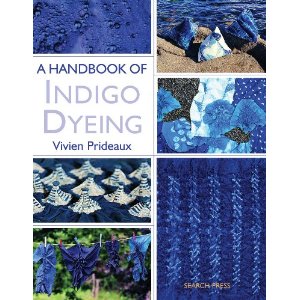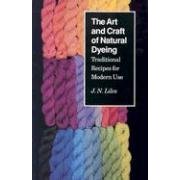Can an herbal mordant substitute for alum in using natural dyes for baby products?
Name: Kelly
—ADVERTISEMENTS—

A Handbook of Indigo Dyeing
by Vivien Prideaux

The Art and Craft
of Natural Dyeing:
Traditional Recipes for Modern Use
by J.N. Liles
Country or region: USA
Message: There is an herbal mordant available from one company that is a combination of two plants: Terminalia Chebula, more commonly known as Myrobalan, and Punica Granatum which is Pomegranate. Can you speak on using an herbal mordant? My friend and I were hoping to create a baby product for the Farmers' Market and were so disappointed to read that the all mordants are virtually toxic. Thanks much.
Both of those plants, myrobalan and pomegranate, are rich in tannins. Myrobalan contains terflavin B and chebulinic acid, while pomegranate contains punicalagins.
Tannins are commonly used for mordanting cellulose-containing fibers such as cotton and linen. They work best as mordants when combined with a metal ion mordant. A very popular method is to mordant cotton first by boiling it with alum, then by boiling it with tannin, and finally by mordanting again with alum, before dyeing with natural dyestuffs. This results in richer and longer-lasting colors than mordanting with tannin alone.
It is possible to use tannins alone to mordant your plant-based fabric before or after dyeing, but the results will not be as colorful and will wash out more quickly than if you use tannins plus alum. They are best used for items that will not be washed too often. Unfortunately, baby products usually require frequent washing.
Both myrobalan and pomegranate can also be used as dyes themselves, rather than solely for mordanting. Without metal-ion mordants, the colors yielded tend to be dull yellowish browns. I am not sure how popular these colors would prove to be among purchasers of baby items.
For those determined to use only natural dyes, a better choice for baby products is to use indigo, which can be made from both plant-derived and synthetic sources. Indigo requires no mordants at all; instead of being bound to a metal ion which is itself bound to the fiber, indigo is changed to a soluble form and allowed to penetrate within the textile fibers before being allowed to return to the non-soluble blue form. While the application of indigo to fabric requires caustic chemicals, these chemicals are completely removed from the fabric before the dyeing process is done. Indigo itself is safe enough for a synthetic derivative, indigotine, to be certified as a food color, FD&C blue #2. Indigo dyeing is more challenging than other forms of dyeing because of the need to chemically reduce the dye, but it is the best of all natural dyes for those who don't want to use mordants.
Whether mordanting with alum is a bad idea for baby products is open to debate. Alum is certainly the safest of all metal-ion mordants, safer by far than chrome or tin, and safer than copper or even iron. However, the fatal dose is surprisingly small, thirty grams for an adult; for a fifteen-pound baby, you would expect the fatal dose to be about one tenth of this, or three grams. Of course for any poison a dose well below the fatal one may still cause illness, such as an upset stomach or nausea. How small a dose of alum is safe for a baby to ingest by chewing on alum-mordanted fabric? The amount ingested in this way should be small enough to be harmless, but using the right synthetic dyes that do not leech out of fabric is safer still. (See "Substitutes for alum as a mordant for baby clothes".)
It's worth noting that before the introduction of synthetic dyes all baby products, at least in Europe and the US, were commonly only one color, white. There is no long tradition of using natural dyes to dye baby products.
(Please help support this web site. Thank you.)
(Please help support this web site. Thank you.)
Posted: Monday - July 23, 2012 at 10:03 AM
Follow this blog on twitter here.
Quick Links
- All About Dyes & Dyeing Top -
- Top of this blog -
- FAQ -
- The Dye Forum -
- How to Tie Dye - How to Batik -
- Books - Toys - Plants -
- Top of this blog -
- FAQ -
- The Dye Forum -
- How to Tie Dye - How to Batik -
- Books - Toys - Plants -
More in this category:
- -
Statistics
Total entries in this blog:
Total entries in this category:
Published On: Aug 29, 2012 02:49 PM
Total entries in this category:
Published On: Aug 29, 2012 02:49 PM
